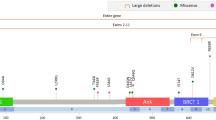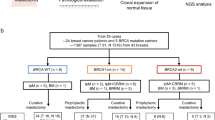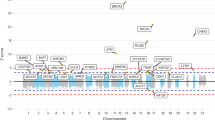Abstract
BARD1 (BRCA1-associated RING-domain 1) is a tumor suppressor whose protein product interacts with BRCA1, and in which rare somatic and germline mutations have been reported in breast, uterine, and endometrial cancers. We aimed to evaluate whether there are BARD1 genetic variants that contribute to breast cancer risk by screening the gene for germline alterations in 45 Finnish familial breast cancer patients and in seven patients with both breast and ovarian cancer. Two of the missense alterations identified (Cys557Ser and Val507Met) were recently suggested to associate with an increased breast cancer risk. We also analyzed these variants in large and independent series of familial and unselected breast cancer patients and healthy controls. No clearly deleterious mutations were detected in the initial mutation screening. No association of the Cys557Ser and breast cancer risk was observed as the variant was found altogether in 1.4% (16/1181) of familial and 2.2% (34/1565) of unselected breast cancer patients, and in 2.5% (27/1083) of healthy controls. The frequency of the Val-allele of the Val507Met variant was modestly higher among breast cancer patients than among healthy controls, although the difference did not reach statistical significance. No statistically significant association of the Cys557Ser or Val507Met variants with any clinicopathologic parameters was observed. These results suggest that the contribution of the BARD1 germline variants to breast cancer predisposition is very limited, and that neither Cys557Ser nor Val507Met have an effect on familial breast cancer susceptibility.
Similar content being viewed by others
Log in or create a free account to read this content
Gain free access to this article, as well as selected content from this journal and more on nature.com
or
References
Ford D, Easton DF, Stratton M et al: Genetic heterogeneity and penetrance analysis of the BRCA1 and BRCA2 genes in breast cancer families. The Breast Cancer Linkage Consortium. Am J Hum Genet 1998; 62: 676–689.
Vahteristo P, Eerola H, Tamminen A, Blomqvist C, Nevanlinna H : A probability model for predicting BRCA1 and BRCA2 mutations in breast and breast–ovarian cancer families. Br J Cancer 2001; 84: 704–708.
Meijers-Heijboer H, van den Ouweland A, Klijn J et al: Low-penetrance susceptibility to breast cancer due to CHEK2(*)1100delC in noncarriers of BRCA1 or BRCA2 mutations. Nat Genet 2002; 31: 55–59.
Vahteristo P, Bartkova J, Eerola H et al: A CHEK2 genetic variant contributing to a substantial fraction of familial breast cancer. Am J Hum Genet 2002; 71: 432–438.
Kilpivaara O, Vahteristo P, Falck J et al: CHEK2 variant I157T may be associated with increased breast cancer risk. Int J Cancer 2004; 111: 543–547.
Antoniou AC, Pharoah PD, McMullan G, Day NE, Ponder BA, Easton D : Evidence for further breast cancer susceptibility genes in addition to BRCA1 and BRCA2 in a population-based study. Genet Epidemiol 2001; 21: 1–18.
Antoniou AC, Pharoah PD, McMullan G et al: A comprehensive model for familial breast cancer incorporating BRCA1, BRCA2 and other genes. Br J Cancer 2002; 86: 76–83.
Wu LC, Wang ZW, Tsan JT et al: Identification of a RING protein that can interact in vivo with the BRCA1 gene product. Nat Genet 1996; 14: 430–440.
Thai TH, Du F, Tsan JT et al: Mutations in the BRCA1-associated RING domain (BARD1) gene in primary breast, ovarian and uterine cancers. Hum Mol Genet 1998; 7: 195–202.
Kleiman FE, Manley JL : The BARD1–CstF-50 interaction links mRNA 3’ end formation to DNA damage and tumor suppression. Cell 2001; 104: 743–753.
Irminger-Finger I, Leung WC, Li J et al: Identification of BARD1 as mediator between proapoptotic stress and p53-dependent apoptosis. Mol Cell 2001; 8: 1255–1266.
Yoshikawa K, Ogawa T, Baer R et al: Abnormal expression of BRCA1 and BRCA1-interactive DNA-repair proteins in breast carcinomas. Int J Cancer 2000; 88: 28–36.
Karppinen SM, Heikkinen K, Rapakko K, Winqvist R : Mutation screening of the BARD1 gene: evidence for involvement of the Cys557Ser allele in hereditary susceptibility to breast cancer. J Med Genet 2004; 41: e114.
Ishitobi M, Miyoshi Y, Hasegawa S et al: Mutational analysis of BARD1 in familial breast cancer patients in Japan. Cancer Lett 2003; 200: 1–7.
Vehmanen P, Friedman LS, Eerola H et al: Low proportion of BRCA1 and BRCA2 mutations in Finnish breast cancer families: evidence for additional susceptibility genes. Hum Mol Genet 1997; 6: 2309–2315.
Eerola H, Blomqvist C, Pukkala E, Pyrhonen S, Nevanlinna H : Familial breast cancer in southern Finland: how prevalent are breast cancer families and can we trust the family history reported by patients? Eur J Cancer 2000; 36: 1143–1148.
Syrjakoski K, Vahteristo P, Eerola H et al: Population-based study of BRCA1 and BRCA2 mutations in 1035 unselected Finnish breast cancer patients. J Natl Cancer Inst 2000; 92: 1529–1531.
Kilpivaara O, Bartkova J, Eerola H et al: Correlation of CHEK2 protein expression and c.1100delC mutation status with tumor characteristics among unselected breast cancer patients. Int J Cancer 2005; 113: 575–580.
Syvanen AC, Sajantila A, Lukka M : Identification of individuals by analysis of biallelic DNA markers, using PCR and solid-phase minisequencing. Am J Hum Genet 1993; 52: 46–59.
Houlston RS, Peto J : The future of association studies of common cancers. Hum Genet 2003; 112: 434–435.
Dechend R, Hirano F, Lehmann K et al: The Bcl-3 oncoprotein acts as a bridging factor between NF-kappaB/Rel and nuclear co-regulators. Oncogene 1999; 18: 3316–3323.
Jefford CE, Feki A, Harb J, Krause KH, Irminger-Finger I : Nuclear–cytoplasmic translocation of BARD1 is linked to its apoptotic activity. Oncogene 2004; 23: 3509–3520.
Ghimenti C, Sensi E, Presciuttini S et al: Germline mutations of the BRCA1-associated ring domain (BARD1) gene in breast and breast/ovarian families negative for BRCA1 and BRCA2 alterations. Genes Chromosomes Cancer 2002; 33: 235–242.
Acknowledgements
We thank Dr Päivi Heikkilä for her help with tumor data, Minna Merikivi, Nina Puolakka, Päivi Virtanen, and Kristiina Selkee for patient contacts, and Kati Rouhento and Johanna Tommiska for technical assistance. The Finnish Cancer Registry is gratefully acknowledged for cancer data. This study was financially supported by the Helsinki University Central Hospital Research Fund, Finnish Academy of Sciences, Finnish Cancer Society, Sigrid Juselius Foundation, Foundation of the Finnish Cancer Institute, Maud Kuistila Foundation, and the Medical Research Fund of Tampere University Hospital.
Author information
Authors and Affiliations
Corresponding author
Rights and permissions
About this article
Cite this article
Vahteristo, P., Syrjäkoski, K., Heikkinen, T. et al. BARD1 variants Cys557Ser and Val507Met in breast cancer predisposition. Eur J Hum Genet 14, 167–172 (2006). https://doi.org/10.1038/sj.ejhg.5201542
Received:
Revised:
Accepted:
Published:
Issue date:
DOI: https://doi.org/10.1038/sj.ejhg.5201542
Keywords
This article is cited by
-
Germline variants associated with breast cancer in Khakass women of North Asia
Molecular Biology Reports (2023)
-
BARD1 mystery: tumor suppressors are cancer susceptibility genes
BMC Cancer (2022)
-
Analysis of large mutations in BARD1 in patients with breast and/or ovarian cancer: the Polish population as an example
Scientific Reports (2015)
-
The BARD1 Cys557Ser variant and risk of familial breast cancer in a South-American population
Molecular Biology Reports (2012)
-
Cancer predisposing BARD1 mutations in breast–ovarian cancer families
Breast Cancer Research and Treatment (2012)



